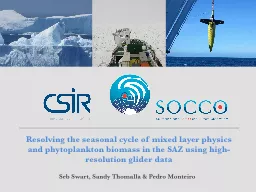

Seb Swart Sandy Thomalla amp Pedro Monteiro Chl a seasonal c ycle Thomalla et al 2011 Complex balance between light and nutrient limitation that drives higher production in SAZ ID: 286497
Download Presentation The PPT/PDF document "Resolving the seasonal cycle of mixed la..." is the property of its rightful owner. Permission is granted to download and print the materials on this web site for personal, non-commercial use only, and to display it on your personal computer provided you do not modify the materials and that you retain all copyright notices contained in the materials. By downloading content from our website, you accept the terms of this agreement.
Slide1
Resolving the seasonal cycle of mixed layer physics and phytoplankton biomass in the SAZ using high-resolution glider data
Seb Swart, Sandy
Thomalla
& Pedro
MonteiroSlide2
Chl
-a seasonal
c
ycle
Thomalla
et al., 2011
Complex balance between light and nutrient limitation that drives higher production in SAZ
>> Sub-seasonal variability of MLD modulates this balance
Joubert
et al.,
submitted
Recent work highlights importance of seasonal to
sub-seasonal
forcing of ML on
PP
(Levy, Klein, 2009; Thomalla et al., 2011; Fauchereau et al., 2011)
The overall
Chl variance that is explained by the seasonal cycle (0-100%) was computed as the variance explained by the regression of Chl onto a repetition of the mean seasonal cycle.
SAZSlide3
High res
in situ MLD summer progression and variability
17 transects of
XBTs to derive MLD
Light - Fe threshold
(
Jourbert
et al., submitted)
SAZ
Underway
chl
-a south of AfricaSlide4
Well stratified
, punctuated by short winter mixSummer highly
reproducible but winter not
Dominated by heat fluxes.
STZ
APZ
MLDs are deep (±100m)
MLD is
seasonal = 57%
57%
17%
What do gridded datasets tell us?
Monthly EN3-derived Brunt-
Vaisala Frequency and MLD
14%Weak seasonal cycle = 14%Variable MLDs &
weak strat.Assoc with high wind var = 2.5 m.s-1SAZSlide5
HYPOTHESISHigh rates of PP in SAZ are a direct result of MLD variability at submeso-subseasonal scales
(around a threshold depth) that allows for alleviation of both light and Fe limitations at appropriate time scales for phytoplankton growth
Swart et al., 2012
…At
present we
cannot
do this without
continuously
sampling autonomous platforms!
Unless these time scales (sub-seasonal) are
correctly defined in terms physical – biogeochemical coupling, models will not accurately reproduce the seasonal cycle and hence predict future climate states Slide6
Gough Is.
STF
SAF
APF
Gough/Tristan Transect
GoodHope Line
Cape Town
Bathymetry (meters)
= Glider deployment & ship CTD station
= ship based underway measurements
±
2000 nm away…
So seasonal cycle experiment
September
2012 –
March
2013Slide7
SG573
SG574
SG543
SG575
SG542
Surface
– 1000m
1.4 km
horiz
res
2532 dives = 5064 profiles
537 days of sampling
+ ship process studySlide8
FLUORTEMP
SPRING
Bloom PRIMING PERIOD
SUMMER
Bloom Sustaining PERIODSlide9
FLUOR
BVF
T
fSlide10
Cyclone
Cyclone edge
Front edge
Intrusion
Submeso
filament -eddy
Strat
. (BVF)
0-100m & 100-300m
MLD
Fluor
Temp
Density
Poster by S. Nicholson et al:
PP sensitivities to
s
ubmeso dyn and subseas atm forcing Slide11
FLUOR
BVFSlide12
Wind
R
=0.52
Density
MLD
Fluor
Strat
. (BVF)Slide13
Spring – Summer MLD progression…a reminder of scales
5-hrly Glider
Monthly EN3
CFSR 7-daySlide14
Bloom initiations vary depending on the criteria used to define them. Different bloom initiations can be explained by different mechanisms (e.g. Sverdrup’s critical
depth, Taylor and Ferrari’s turbulent convection, Mahadevan’s eddy driven stratification)
>> The
response of the bloom onset to interannual and climatic
change will depend
strongly on which mechanism prevails,
eg. wind/features
2. In
S
pring, feature driven changes to the mixed drives early stratification and bloom initiations>> If climate models don’t include lateral processes they will overestimate
bloom initiation dates3. In Summer, wind driven adjustments to the mixed layer plays an important role in sustaining the summer phytoplankton
bloom by relieving Fe and light limitation at the appropriate time scales>> Highlight the importance of interplay between meso-submesoscale features
versus wind-buoyancy processes
in characterising the ML, productivity, timing
of the bloom and carbon exportConclusionsSlide15
Many thanks to the following people and collaborators!Geoff Shilling, Craig Lee &Eric D’Asaro at APL, UW
Derek &Andre at STS / SOERDCGrant Pitcher & Andre Du Randt, DAFF
Stewart Bernard,
Marjo Krug & Andy Rabagliati
, CSIRGavin
Tutt, DEA
IMT, SANAP, UCT, DEA & DAFF